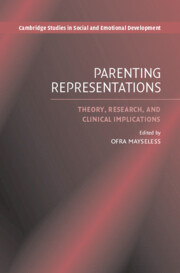Book contents
- Frontmatter
- Contents
- List of Illustrations
- List of Tables
- List of Appendixes
- List of Contributors
- Preface
- Acknowledgments
- Part One Theoretical Perspectives
- Part Two Research Applications
- 4 Communicating Feelings: Links Between Mothers' Representations of Their Infants, Parenting, and Infant Emotional Development
- 5 The Dual Viewpoints of Mother and Child on Their Relationship: A Longitudinal Study of Interaction and Representation
- 6 Modeling and Reworking Childhood Experiences: Involved Fathers' Representations of Being Parented and of Parenting a Preschool Child
- 7 Maternal Representations of Parenting in Adolescence and Psychosocial Functioning of Mothers and Adolescents
- 8 Like Fathers, Like Sons? Fathers' Attitudes to Childrearing in Light of Their Perceived Relationships with Own Parents, and Their Attachment Concerns
- Part Three Clinical Implications
- Index
- Cambridge Studies in Social and Emotional Development
- References
8 - Like Fathers, Like Sons? Fathers' Attitudes to Childrearing in Light of Their Perceived Relationships with Own Parents, and Their Attachment Concerns
from Part Two - Research Applications
Published online by Cambridge University Press: 10 July 2009
- Frontmatter
- Contents
- List of Illustrations
- List of Tables
- List of Appendixes
- List of Contributors
- Preface
- Acknowledgments
- Part One Theoretical Perspectives
- Part Two Research Applications
- 4 Communicating Feelings: Links Between Mothers' Representations of Their Infants, Parenting, and Infant Emotional Development
- 5 The Dual Viewpoints of Mother and Child on Their Relationship: A Longitudinal Study of Interaction and Representation
- 6 Modeling and Reworking Childhood Experiences: Involved Fathers' Representations of Being Parented and of Parenting a Preschool Child
- 7 Maternal Representations of Parenting in Adolescence and Psychosocial Functioning of Mothers and Adolescents
- 8 Like Fathers, Like Sons? Fathers' Attitudes to Childrearing in Light of Their Perceived Relationships with Own Parents, and Their Attachment Concerns
- Part Three Clinical Implications
- Index
- Cambridge Studies in Social and Emotional Development
- References
Summary
Abstract
How does the way parents perceive and remember their relationships with their own parents during childhood relate to their parental attitudes toward their own preschool children? A sample of 62 fathers, aged 22–40, drawn from a longitudinal study of parenthood (Scher, 1991) was used to answer this question. Four factors served to assess the fathers' childrearing attitudes with their 3.5-year-old children: control and authoritativeness; repression; encouragement of verbal and emotional expression; and promotion of autonomy (Block, 1981). The fathers' relationships with their own parents in childhood (acceptance, and encouragement of independence; Epstein, 1983) and fathers' attachment concerns (fear of abandonment and fear of dependency; Mayseless, 1995) were examined by self-reports. Perceived acceptance by fathers' own father was positively associated with rearing attitude of control and repression and negatively with autonomy promotion. A controlling rearing attitude was associated with less behavior problems. Results were discussed as supporting a “model of reference” whereby the paternal role includes reference to experiences with mother and father during childhood that indicates similarity as well as compensation and change.
Studies have documented the intergenerational transmission of risk and vulnerability between parents and their children via both mothers and fathers (e.g., Kendler, 1996). In extreme cases, instances of risk factors have been found, namely a very high likelihood that problems of mothers are transmitted to their children (Bifulco et al., 2002). Similarly, transmission of increased risk was found due to problems with the father's own father.
- Type
- Chapter
- Information
- Parenting RepresentationsTheory, Research, and Clinical Implications, pp. 239 - 262Publisher: Cambridge University PressPrint publication year: 2006
References
- 6
- Cited by



